
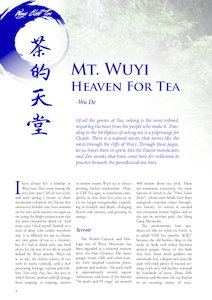 |
|
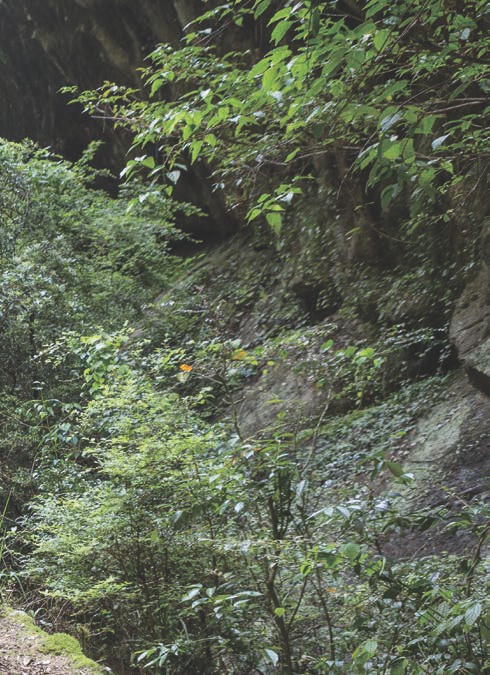
I have always felt a kinship to Wuyi teas. They were among the very first teas I fell in love with, and each spring I return to these mountains to bask in the Nature that creates my favorite teas, have sessions on the very rocks ancient tea sages sat on, using the bright stream water that the trees themselves drink of. And every year I find myself hushed to a state of deep calm unlike anywhere else. It is difficult for me to choose any one genre of tea as a favorite, but if I had to drink only one kind of tea for the rest of my life it would indeed be Wuyi yancha. Wuyi tea is, to me, the richest variety of tea, with so many varietals, and a rich processing heritage, culture and folklore. Not only that, but the way in which flavors, aromas and Qi change from steeping to steeping, session to session means Wuyi tea is always inviting further exploration. Then, as Cliff Tea ages, it transforms completely so that after five years or so it's no longer recognizable, expanding in breadth and depth, changing flavors and aromas, and growing in energy...

The World Cultural and Heritage site of Wuyi Mountain has been regarded as a national treasure since the Han Dynasty. The many gorges, rivers, cliffs and other scenery have inspired countless poets, painters and authors. The park itself is approximately seventy square -kilometers, and most of the famous "36 peaks and 99 crags" are around 400 meters above sea level. There are numerous waterways, the most famous of which is the "Nine Turns River", whose nine bends have been eulogized countless times throughout history. Its source is around two-thousand meters higher and to the east in another park, the Hang Gang Mountain.
The environment here produces tea like no other on Earth. It is called "Cliff Tea (yancha, 岩茶)" because the old bushes cling to the rocks in beds and valleys between natural gorges. Many of the beds that host these small gardens are manmade, but a deeper trek into the park will yield plenty of natural settings, with very old bushes, wizened by hundreds of years. These cliffs enhance and become the tea bushes in an amazing variety of ways, surging all the forces of Nature through this channel towards humans.
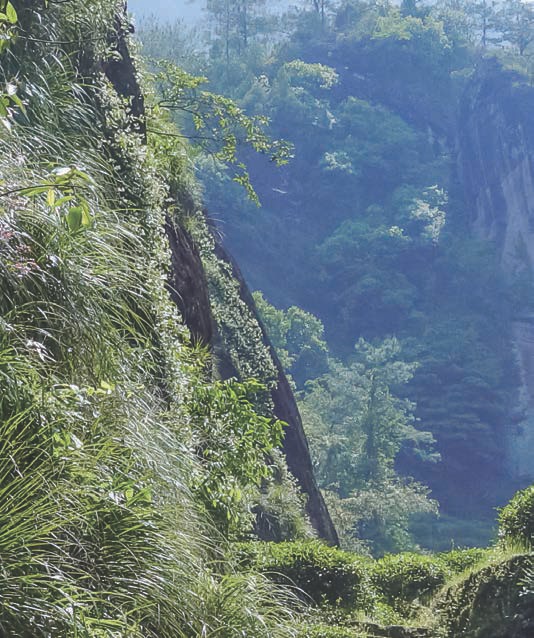
The cliffs on both sides protect the trees from wind and other natural dangers, as well as shielding the bushes from too much sunshine. Many of them allow only the morning and evening light to gather on the bushes. Studies have shown that the reddish-orange light of the morning causes the trees to produce more sugars, while the more purplish light of the evening results in more amino acids and various kinds of proteins. The unique environment here at Wuyi has resulted in a tea with a very unique profile of hydroxybenzene, amino acids, catechins, caffeine and other elements which all affect the nature and quality of a tea.
The cliffs here also aid in tea production, as they funnel daily mist into the valleys, assuring that the tea trees are always humid and moist. Locals have for centuries called this the "Breath of Heaven", claiming that the tea trees breathe in the Qi of the mist and rocks, lending them their "rock flavor". Water is always such an essential aspect of tea, both as the tree flourishes in Nature and in our preparation of the liquor. And as one strolls through the park, the crystal streams and dripping falls that highlight every turn also emphasize the coursing pulse of the mountains, flowing through the Earth to the trees and on to us. The water that streams down these cliffs is full of rich minerals, not only from the countless rocks within the park, but also from the higher mountains to the east. This irrigation has also helped to create the rich, gravely soil that tea sages have said is most suitable for tea since long before Lu Yu made that claim famous.
Besides protection, rich oxygen and minerals, the cliffs also participate in tea production in one other important way: during the day, the rocks and cliffs absorb the sunlight in the form of heat, which they then release throughout the night, comforting the old bushes with a consistent temperature at all times. This is especially important during the harvest season, when slight temperature fluctuations can affect the quality and abundance of the harvest.
While we can explore the different elements of Wuyi tea production, the harmony of sun, rocky soil, water, mist and air is really not something maintained or controlled by the hands of men. The best teas are created by Nature first, and man second. Besides the qualities pointed out here, there are a million subtle ecological relationships between other plants, insects, animals, the mountains and sky, which we'll never fully understand. But is there any need? A nice hike through the park trails to an undisturbed garden, quiet these hundreds of years, leaves you with an impression a thousand, thousand poems could never capture - in awe of Nature and your place in it. Perhaps there is no need to know why Wuyi tea is like none other on Earth, especially when you can drink it. The same sunshine that's in the leaves warms your skin, as you reach down to scoop up some of the smooth, soft water the trees also drink. Eating the amazing local vegetables and walking around a bit more, you realize that like the tea trees here you'd be healthier living here as well.
Wuyi people take great pride in the tea processing skills they've developed over centuries. One of the problems that you can encounter with other popular genres of tea is that the booming tea industry attracts farmers who were previously working with other crops. They then learn the "standard" method of processing for their region and stick to that, day in and day out. Many of the "flaws" in such production come as a result of this formula, which fails to account for all the subtle changes that need to be made for each batch, based on temperature, humidity and many other factors. Watching the ancient wisdom unfold in hand-processed yancha is amazing, as slight adjustments are made all day and night to balance factors that are often felt rather than analyzed. It is an art. And if you've ever tried even the simplest aspect of the process, like shaking the leaves for example, you'll see that it is no wonder why, like any art, it takes decades to master.
But not all Wuyi tea is high quality; not all of it is environmentally protected or processed by hand (or even with any skill). It is therefore important to understand a bit about the four grades of Wuyi yancha and have some guidelines for identifying them.

There are, however, several "distinctions" of Zhen Yan, starting of course with the trees themselves. It is a big park and different locations are better for tea growth than others; places where the trees are older, the water and minerals better, or perhaps where the mist and sunshine are perfect. As mentioned above, the cliff walls absorb the day's sun shine and release it at night, so many locations in the park stay at a constant temperature and humidity during the growing season. This means that the location of the trees in the park has a huge influence on its quality.
Another important factor relates to the fact that the park is such a famous tourist destination. Thousands of people walk through every day, following the clear and defined paths constructed by the government. Consequently, the tea gardens near these paths are all inferior. The noise, cameras and even the breathing of thousands of people all affect the quality of these gardens. The best gardens, on the other hand, are deeper in the park - down dirt paths that take you to silent places well away from all the crowds. Like all plants, tea also responds to human interaction, emotion and even the human voice itself. Before the strict ban, put into effect around 2002, friends picked some of the famous Da Hong Pao from the original bushes, processed it and drank it a few days later. While the tea was amazing, coming from such old and powerful bushes, their guide said that compared to earlier years, the quality had diminished. When I asked him why, he responded that it was definitely because of the thousands of people who come and take photos and make a lot of noise around the trees each day.
Of course, much of the mastery of oolong tea is in the complicated processing, so this is a major factor in the end product as well. The best Zhen Yan is completely hand-processed, though there is also semi-hand-processed and machine-processed tea. It is easy to differentiate the hand-processed from the machine-processed varieties by appearance alone, as the latter produces more uniform leaves, all about the same shape with the same kind of twist, whereas the hand-processed teas display a variety of sizes, shapes and twists unique for each leaf.
Even Zhen Yan from a single garden will be sorted several times, and a variety of grades will eventually be packaged. A lot can go into the distinction. The tea processed by the hand of the master, for example, may be the smallest quantity each year, as his job is mostly to teach and supervise his younger relatives and employees.
A true master never roasts genuine Zhen Yan from within the park heavily. A lot of people have only tried heavily-roasted yancha and therefore have probably not tasted much Zhen Yan, which is produced in smaller quantities and is more expensive as a result. Each of the thousands of varieties of yancha, like "Golden Water Tortoise (Shui Jin Gui)" or "Old Man's Eyebrows (Lao Jing Mei, 老金眉)", has very distinct flavors. "Iron Arahant (Tie Luo Han)", for example, is known to taste of burnt bamboo, while "White Cockscomb (Bai Ji Guan)" tastes of lychee. If the roast is too heavy, these flavors are lost. In fact, almost all Zhen Yan was traditionally stored for six months to a year before drinking so that whatever roast there was mellows out, leaving behind the flavors of the leaf. Like all oolong, mastery in roasting is when the roast affects the flavor in a positive way without leaving behind any traces of itself. The exception to this rule is the "mistaken" Zhen Yan tea, which is heavily roasted. As each variety of tea is hand-processed, some percent of it is sorted down, due to all kinds of mistakes, natural and human. This tea is set aside with all the "down-sorted" tea. At the end of the processing period, there is then a bulk of this tea all mixed up - with "Shui Jin Gui", "Tie Luo Han" and the other varieties processed that year. This pile of mixed tea is then heavily roasted to cover up the differences in the leaves, and sold under the generic, all-encompassing "Da Hong Pao" that denominates all low-quality tea from Wuyi. Many of the best heavily-roasted teas are of this variety, as they at least come from Zhen Yan. A look at the wet leaves can often show if the tea was blended.

This is what you could call "Halfway Cliff Tea". It grows on the hills and cliff sides of the immediate edges of the park. A lot of these gardens are planted in the traditional way, like Zhen Yan: on terraces with a meter or so between each tree, which is left to grow strong and old. Some of these gardens are actually quite old as well and some are even organic, though much less than in the park.
Ban Yan can be a shady division because some of the gardens that are just outside what the government has demarcated as the park produce better tea than some of the worst locations within the park. Also, a lot of Ban Yan is right on the border, and there are trees just on the other side of a cliff that could be called Zhen Yan. For the most part, these trees lack what the best quality yancha has: cliffs on both sides, which not only absorb and release heat, as we discussed earlier, but also drain minerals down from both sides into streams of nutrient-rich waters for the trees. This water also keeps the soil aerated, loose and gravely.
As with Zhen Yan, processing will play a huge part in determining the quality of a Ban Yan as well. Much less of this tea is hand-processed, as it does not warrant the attention and cost in energy. Hand-processing oolong tea is very labor intensive and during the harvest season many of the masters get very little sleep.
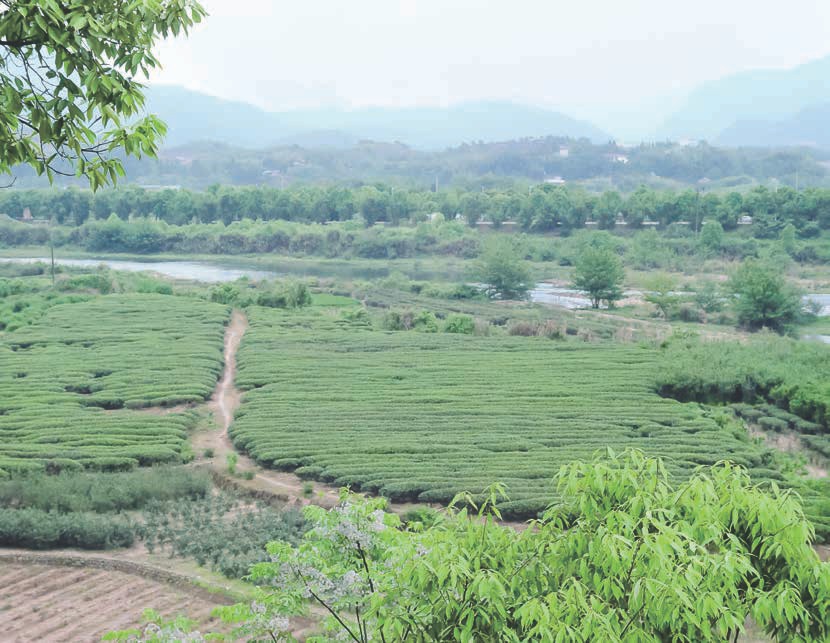
In this category, much of what makes yancha special is lost. The distinct flavors of certain varieties of yancha have as much to do with their special location in the park as they do with the genetics of the trees themselves, which is why tea masters in Wuyi only really refer to the six original trees as "Da Hong Pao". Even grafting clones and planting them elsewhere will eventually result in a new variety of tea as the trees adapt and interact with their new surroundings - like the first generation "Da Hong Pao" planted in the now-famous Bei Dou area.
Also, farming by the river ceases to be about quality and starts to march to the economic drum. For that reason, very little of it is organic and it is often harvested year round, as in other tea-growing regions around the world. All of this tea is heavily roasted, which, as we discussed, is almost always done to cover up inferior quality leaf, and sold as generic "Da Hong Pao". Most of this tea is sold raw to large factories that machine process it. (In fact, some farmers have even begun to sell their Zhen Yan to the factories rather than process it themselves.)
Literally "Grown Outside", this tea is propagated in the hills surrounding the park. It shares in none of the richness that makes Wuyi tea special. This tea is all from lower altitude, inorganic, hedged and pruned little trees that are over-harvested into the ground, like in most tea-growing areas in the world. This tea is all about mimicking real Wuyi tea, with heavy roasts to cover up any trace of flavor that could possibly infuse from the tea itself. Basically, these are farms that have, over the years, jumped on the "Da Hong Pao" bandwagon and converted their land to tea production to cash-in on the growing interest. I have some of this tea from a trip in 2001 that to this day still has not lost its roast, so that when you open the jar or brew the tea, the roast-flavor and aroma is as strong as it was the day it was roasted. Zhou Cha and Wai Shan represent around sixty percent of all Yancha.
Yancha must pass through many stages in its production before it is ready to be brewed and enjoyed, and if any one of them is done improperly the tea's quality will be compromised. There aren't any secret recipes involved; rather, the beauty of the tea depends upon mastery of technique gained only through experience. Tea-producers have been handling this tea for generations, first watching as they were children, then participating more and more as they got older. The masters have lived Wuyi Tea Dao for decades.
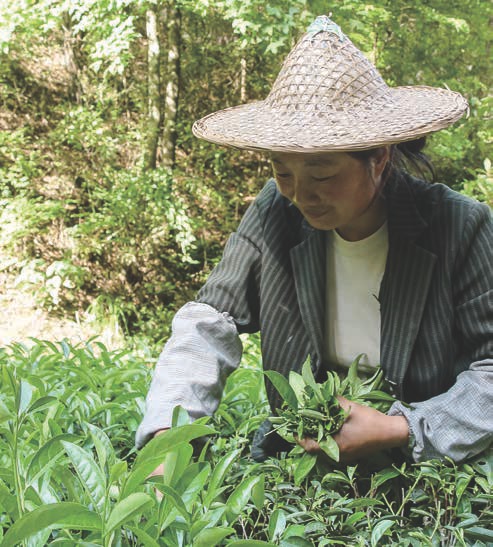
At the start of the season, local monks hold a large ceremony. They make offerings, burn incense and place fruit upon the altar before chanting through the morning. The Master Guide, the tea-pickers and porters are all blessed in turn before they set out. They remain silent as they walk to the tea bushes for the first time. This comes from a tradition of respect for the spirits of Nature. They sometimes hike for miles in order to reach the tea bushes, which are often high up amongst the cliffs. Before the leaves are ever seen there is a reverence - a sense of the Sacred amongst even the lowest porter.
The Master Guide's second job is to direct the pickers, showing them exactly which leaves to pick. Tea leaves grow alternately on their stems, not opposite from one another. Traditionally, only the first three leaves of each branch were taken. However, the increased demand for Wuyi Cliff Tea has made the Master Guides more lenient. Nowadays, the leaves are picked down to what is called the "fish eye" (yu yen, 魚眼), a small curled leaf residing about five leaves down the stem. The leaves below the fish eye are reserved for the next season. Despite the increased yield in recent times, the leaves that are lower down, between the fish eye and the third leaf, are lower quality and later downgraded in the sorting, so that even today the first three leaves are separated and packaged together to create the highest quality Cliff Tea.
The picking process can become extremely complicated. Even the placement of the bush must be taken into account. The side facing east will be blessed with more morning sunshine and therefore grow larger leaves that are opened more. The backside, on the other hand, will have more buds. These teas must be separated. Sometimes blends are made, if the mixture will have a better flavor, but all of this must be conducted by a master with years of experience.
After showing the pickers which leaves to take, the Master Guide can step back and supervise. The best pickers are often elderly ladies, as the picking is a delicate process. If a leaf is dropped to the ground it is considered spoiled and left behind. These older women have the experience and dexterity to pick the tea with the most efficiency. Often, it is only the women who pick the tea, and then male porters carry it back to the village. The paths are often steep and treacherous and the baskets heavy (100 kg). But I have seen men picking and strong women carrying the baskets on occasion. When the tea is harvested to the fish eye the Master Guide will order the pickers to halt. They return to the village at a quicker pace than they walked on the way there, because the tea must reach the village as soon as possible to start the processing. Almost the entire process occurs on the same day the leaves are picked.
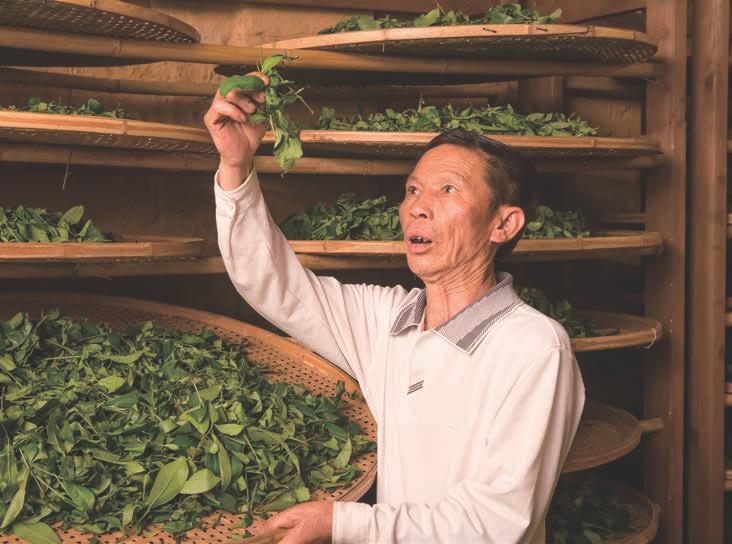
When the leaves arrive at the village they are gently placed on round bamboo trays. Sometimes a tarp is laid on the ground if the leaves are of lower quality or higher yield. The leaves are arranged neatly in a single layer, using as many trays as necessary, then left to wither. The leaves are withered because the moisture in tea leaves makes them too fragile for processing; they would only break. The withering accordingly prevents breakage by making the leaves slightly limp in preparation for the rest of the procedure. There is never a moment in which they aren't monitored. If it is too sunny or too hot, the leaves could be burned, which would ruin them. Also, if they are left to wither for too long, they will become overly-oxidized and must be discarded. The leaves must reach the desired level of flexibility, no more or less.
Periodically, the trays will be brought inside and placed on shelves, where the temperature and light can be controlled more precisely. This stage is sometimes called, "reduction." When the leaves come inside out of the sun, they begin to stiffen slightly. This is called "huan yuan (還原)" in Chinese, which literally means "alive again." A master watches the leaves and moves them in and out of the room as many times as necessary to reach the desired flexibility and degree of oxidation. Much of this depends on the weather for that day, the time of day, the strength of the sun and the nature of the leaves themselves. Like any aspect of life, it's about finding the right degree. Masters know by sight and touch when the leaves are ready for the next stage. The harvest day is usually chosen at a time when there won't be any weather issues that could potentially disrupt production, though contingencies exist. Subtle changes result if the tea is processed on a rainy day, and therefore dried indoors. On such a day, at best, sixty percent of normal quality can be reached.
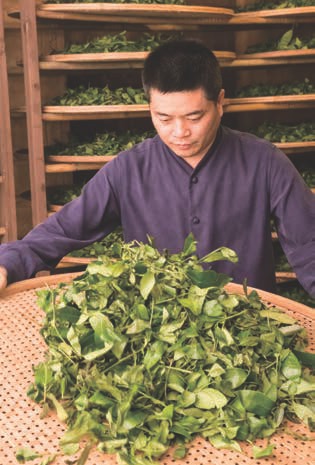
The shaking part of the process is the predominant stage that separates oolong from all other varieties of tea. A round, woven bamboo tray is held firmly in two hands and the leaves are vigorously shaken. Shaking the leaves requires great skill. There is a rhythm to the process. It takes strength and endurance to shake the leaves and wisdom to know when they are finished. The shaking bruises the leaves, which encourages oxidation. The master producers try to bruise only the edges so that they will later develop a reddish hue that makes the leaves beautiful to look at and more delicious to drink. It is quite difficult to achieve this by hand.
After shaking, the bruised leaves are placed on shelves to oxidize. The shaking and oxidation will be continued at regular intervals until the master who oversees the production declares that the tea is sufficiently oxidized to move on to the next stage. It is this keen eye which distinguishes the masters from the skilled apprentices. Charcoal braziers are often used to masterfully control temperature and humidity, guiding the oxidation to the desired degree.
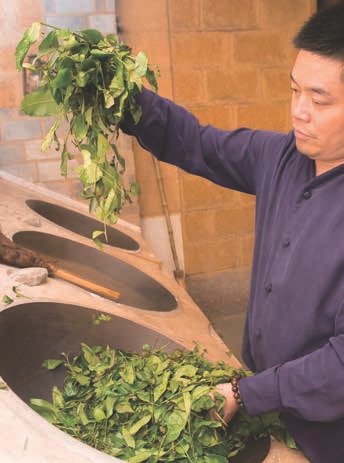
When the tea has finished oxidizing it is time to fry it. The frying of tea serves two purposes: First, the frying arrests the oxidation process. If the leaves were allowed to further oxidize, they wouldn't taste and smell the same. Secondly, the frying destroys certain enzymes in the leaves that give them a bitter, grassy taste. For that reason, the frying of the leaves is often called the "killgreen stage" (sa qing, 殺菁).
When the process is done in the traditional way, by hand in a large wok, the person frying must know when the leaves are finished by touch alone. It takes many years of practice before a student is allowed near the best quality teas. The fingers must remain firmly closed so that no leaves get caught between them. The leaves are pushed to the center and then stirred outwards again. If the leaves are slightly damp the person frying will gently pull them up from the center and drop them to evaporate any excess moisture. The leaves must be pulled because they are too hot to reach under. Besides the heat and moisture, a lot of things are going on during this stage. The person frying must concentrate. A lot depends on this phase of the process.
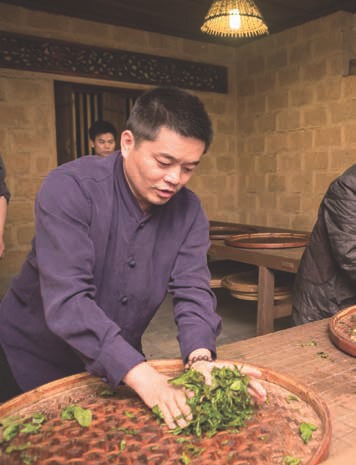
The shaping of the leaves must happen immediately after frying. The temperature mustn't decrease at all. This often requires the cooperation of more than one worker. The leaves are quickly carried to bamboo trays that have raised ribs woven into them. The shaping (rou nien, 揉捻) is done with rolling, kneading motions and is done for several reasons: Firstly, it causes the leaves to dry in a curled shape that is both pleasing and saves on packaging space. More importantly, rubbing the leaves across the bamboo ribs bruises the cellular structure of the leaves. The combination of the curled shape and bruised structure will cause the leaves to slowly release their essential oils, flavors and aromas when they are steeped. The bruising also changes the way in which the tea will oxidize during the rest of production as well as the way it will age.

When the tea is shaped properly, it is ready to be roasted (hong bei, 烘焙). Smaller factories that produce Wuyi tea by hand do not have time to complete the roasting during the harvest season. There isn't enough space or people to complete all the other steps and roasting on the same day. For that reason, only the best teas will be roasted start to finish on the same day. The greater bulk of the tea will go through a short initial roasting, called "zou shui bei (走水焙)", or "temporary roasting", which stops the oxidation process and puts the tea "on hold" for a short time. It is then carefully stored until all the tea has been gathered for that season. This could take days or even weeks depending on the factory and farm. When all the tea has been picked and processed, it is roasted. The second roasting, referred to as "zhu bei (足焙)" or "completing the roasting" is then conducted under the supervision of the masters. All of the laborers cooperate in this longer roast, which requires constant supervision. Any stage of the process can damage the quality of a tea, but the roasting is perhaps more evident than the other stages. A poor roasting is immediately noticeable in the first sip.
To roast the teas, compact charcoal is placed in wells. Rice ash is used to cover the coals, reducing the temperature to inhibit any flame. The roasting must be through heat alone, as a flame would cook the tea. The tea is stirred and spread out regularly throughout the roast.
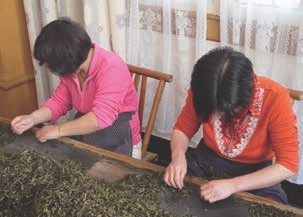
The teas are sorted on large tables by masters. The first three leaves, which are of higher quality, are separated into piles. The sorting is very time consuming, and done very carefully to maximize the amount of higher-grade leaves for the market. Sometimes a winnower is used to remove dust particles from the lower quality leaves.
Because the process takes a long time, the leaves will again be exposed to moisture in the air. For that reason, when the sorting is finished, the leaves are then roasted again for a very quick spell. This dries them out. The best Wuyi teas are packaged while they are still hot from this final, swift roasting.
There were eight hundred kinds of yancha in the Qing Dynasty. Now there are only a few dozens left. Many of the more unique varieties are limited to a few bushes only. They are unique mostly because of the differences in their locations, sunlight, minerals, soil and water. I have one small canister of a yancha made from a single bush, called "Old Bright Star (Lao Shou Shin, 老壽星)", that is more than three hundred years old. The four most famous varieties of yancha are "The Emperor's Crimson Robe (Da Hong Pao)", "Iron Arahant (Tie Luo Han)", "Golden Water Tortoise (Shui Jin Gui)", and our tea of the month, "White Cockscomb (Bai Ji Guan)". "Water Fairy (Shui Xian, 水仙)" and "Cinnabar (Rou Gui, 肉桂)" are also quite common varietals. Each has a history and legend surrounding its name, a special leaf-shape and even subtle nuances in processing and drinking. Perhaps a brief exploration of the three remaining "Four Legendary kinds of Yancha" will be useful here (we discussed Bai Ji Guan in the Tea of the Month article):
Da Hong Pao, The "King of Tea" is the best known of all Wuyi yancha. It is also the best of the bunch, admired near and far in both the modern and antique age. It was often a favorite tribute of the royal court. The origin of this marvelous tea is the cliff of Tian Xin Yan, Jiu Long Ke of Wuyi. It received its name of "The Emperor's Crimson Robe" in the Qing Dynasty. Since the 1980's, Da Hong Pao farms have spread down into the inner mountains of Wuyi. Da Hong Pao grows from a medium-sized bush with leaves that belong to an asexual reproduction based on late-grown seeds. The plant has a half-open shape with thick branches in close proximity. Its leaves are elliptical, bright and dark-green in color. There is a slight bulge on the surface and sharp, dense teeth around the edges. They give the impression of being thick and yet fragile at the same time. The buds are tender, showing a carmine color with lots of little hairs, and their fertility is strong and dense. The diameter of the corolla is approximately 3.5cm with six petals. Late in April the blossoms display themselves with great luxuriance. Overall, Da Hong Pao is of medium output compared to other yancha. The dry tea is tight and solid with mixed greens and browns throughout. The tea is full-bodied and has the fragrance of osmanthus flowers. It is especially famous for the sensations (cha yun, 茶韻) it brings, especially to the upper palate, and a rich, long-lasting aftertaste (hui gan, 回甘). True Da Hong Pao is said to taste and smell of the citrus spray that flies off an orange as it is peeled. I have often smelled and tasted this when drinking high-quality, first-generation tea from the Bei Dou area. There are several grades of Da Hong Pao that are mostly evaluated in terms of their genetic proximity to the six original bushes. Some tea masters suggest that since Da Hong Pao has become such a generic term, perhaps it is more akin to a brand name than a variety of tea. Consequently, some masters only use the term "Da Hong Pao" to refer to the original six bushes, calling other varietals by the location in which they grow and their genetic approximation to the original bushes, like "Bei Dou First Generation" for example.
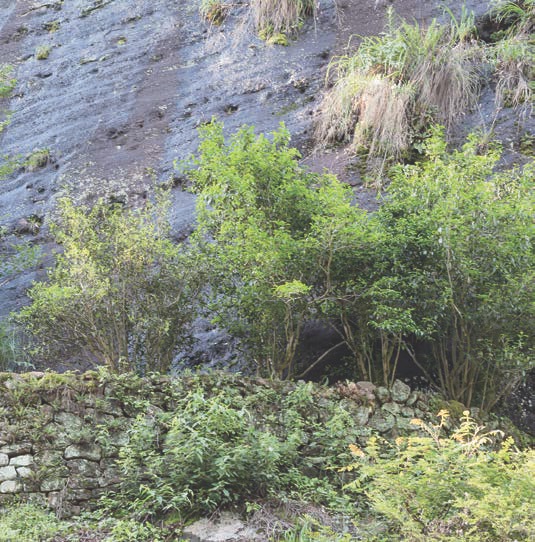
Tie Luo Han received its name long before any of the other traditional teas of Wuyi, in the Song Dynasty. It is the earliest of all known Wuyi teas. It originates in the Nei Gui Ken of Hui Yan. The tea trees are planted on a long, narrow belt beside a small ravine with cliffs on both sides. The trees are therefore taller and bigger than the other varieties, with a half-open shape and crowded branches. The leaves are also elliptical, though slightly longer. They are dark green, bright and thick with dull, shallow teeth around the edges. The buds are reddish-purple with a lot of hairs. They are also very fertile, yet tender. The diameter of the corolla is 3.5cm and shines brightest in the middle of April. The buds yield a very high harvest, and are the raw material for this tea. Because Tie Luo Han is almost all bud, the tea is sweeter and thicker than the other kinds of Wuyi tea. It has a rich fragrance with a very fresh aftertaste that quenches the thirst and offers a very characteristic sensation of cleanliness in the mouth. It is known to taste and smell a bit like roasted, or even burnt bamboo.
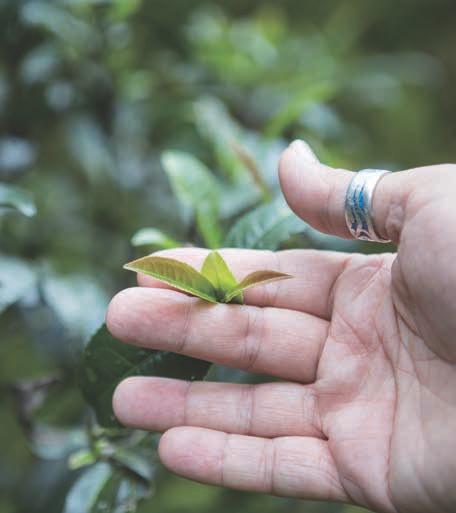
This tea originates on the Du Ge Zhai Peak, Niu Lan Keng of Wuyi. It has played an important part in the culture and economy of the region since the 1980's. According to legend, it received its name in the Qing Dynasty, though the plant is much older. Like Da Hong Pao, Shui Jin Gui is a medium-sized bush and leaf cultivated asexually from late-grown seeds. The main distribution of Shui Jin Gui is in the inner mountains of the Wuyi region. The branches are dense and the leaves elliptical. They too are dark green in color. The surface also bulges like Da Hong Pao, but the edges display a slight wave with tiny, sharp teeth. The leaves also fold inwards in a unique way. The buds are tender and a unique purple and green with flowery hairs; their fertility is dense. The diameter of the corolla is 3cm and usually boasts seven or eight petals. In mid-April they shine the brightest. This tea likewise offers a medium output. The color of the dry leaf is bluish. When finished it is smooth, fat, tight and even. When a package is opened, the leaves are all tangled together, which has earned it the nickname "Head of the Dragonfly". The tea is rich and fragrant with hints of plum and osmanthus. The liquor is a clear and deep orange color, and should have a full body, obvious sensation and deep aftertaste.
